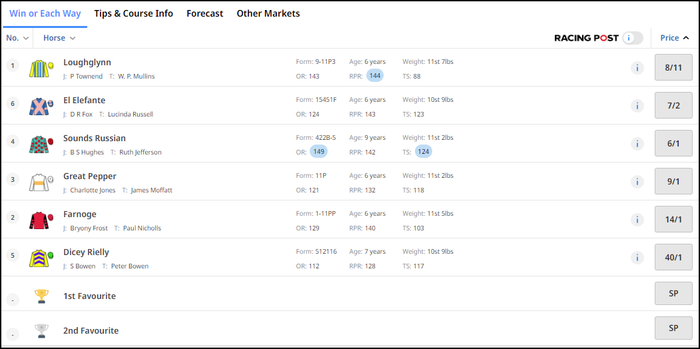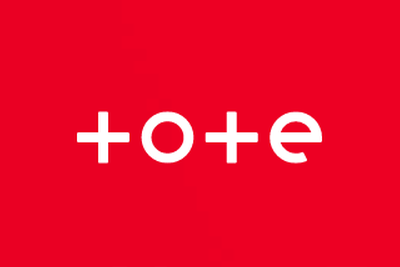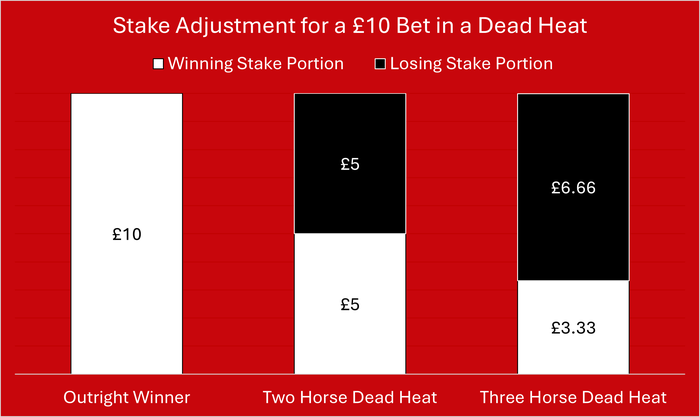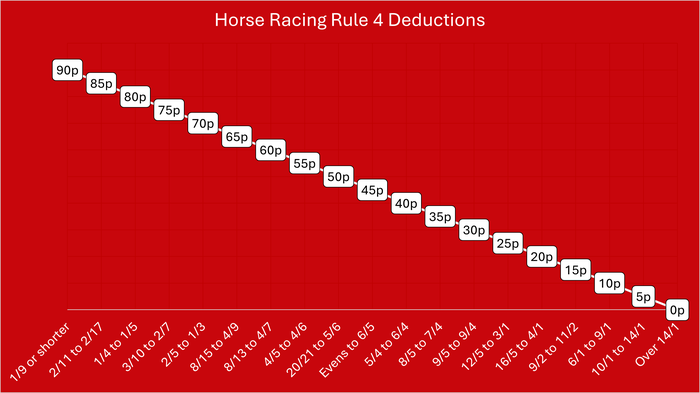 Horse racing has been one of the largest UK sports betting markets for many years now and continues to fly the flag at the top of the pile. It generates hundreds of millions each year for bookmakers and allows punters a constant stream of races to bet on.
Horse racing has been one of the largest UK sports betting markets for many years now and continues to fly the flag at the top of the pile. It generates hundreds of millions each year for bookmakers and allows punters a constant stream of races to bet on.
There are very few sports like horse racing in which betting plays such a big role. In fact, if for whatever reason betting was made illegal tomorrow, it’s highly likely the sport wouldn’t attract nearly as many punters. and in response the sport would likely decline massively.
Betting is so deeply ingrained in horse racing that it’s not uncommon to find many of the larger races – and even some smaller ones – sponsored by UK bookmakers hoping to get punters using their betting service. After all, where better to advertise for a bookmaker than a sport that is so heavily tied with betting.
The coverage of the sport is also a massive factor into horse racing’s popularity. Races can be found around the UK on a daily basis and often more than just one meeting. This means that online bettors can take advantage of daily racing cards resulting in the availability to bet almost 365 days a year.
Popular Horse Racing Bets / How To Bet On Horse Racing

Horse racing betting can be as simple or as complicated as you wish to make it. Some of the bets can be quite complicated and even tough to work out potential pay-outs, but we will run you through some of the more popular with a couple of curve balls as well that you may not have known about.
- Win Bet – Without doubt the most common bet is the win only bet. You simply pick the horse that you think will win
- Each Way Bet – Each way betting is where you essentially place two bets; the first on the win market and the second on the place market. Before the race the bookmaker will tell you how many places they will pay in an each way market depending on the amount of runners. If you were to put £25 on each way, your stake would equal £50 (£25 on the win market and £25 on the place market). If your horse fails to finish outside the places paid then you will lose your bet. If your horse finishes first then you will receive money for winning the race and from placing in the race. If the horse manages to place but not win, then you will receive the odds on just the place market
- Place Only – Many of the betting exchanges will allow you to bet on the horse placing alone so you don’t need to essentially make two bets such as the each way market
- Lay Bet – Sticking with the betting exchanges, you can lay a horse rather than backing it meaning you expect this horse to lose. It’s an easy way to become your own bookmaker in reality, setting lines and then laying odds
- Forecasts & Tricasts – These are bets to predict the horses finishing first and second in a race (forecast) and first, second and third in a race (tricast)
- Accumulator – An accumulator allows you to pick the right result in more than one race to increase the odds and hit a potentially large payday. Many bettors like to take a few strong favourites on their accumulator to make what initially would be short odds placing on a single market, into much more appealing odds by taking on a few races
- Tote Betting – The Tote offer an array of betting types for its punters and is a good way to change up your betting patterns to keep everything fresh. Let’s take a look at couple of the more popular ones
- Scoop 6 – The Scoop 6 is probably the Tote’s biggest betting pool where you need to correctly guess the winners of 6 races that are shown on Channel 4 on Saturday to be in with the chance of winning a massive jackpot. The Scoop 6 was the bet that made the first horse racing millionaire from just one bet
- Placepot – Similar to an each way bet, you need to select the horse that finishes in the paid places. The places depend on the amount of runners in the event
- Top Trainer – You often find these markets at the major meetings such as the Cheltenham Festival where you pick which trainer will have the most wins. You can also bet on the flat and jumps seasonal Trainer Championships where you can bet on who will win the most prize money
- Top Jockey – As with the trainers championships, you can bet on the top flat and jumps jockeys in a season, with the Champion the jockey with with the most winners. These are again available for the big meetings such as Royal Ascot
- Betting Without the Favourite – This is where a new field of runners in a race is created without the favourite, betting on which horse will finish in the highest race position
- Quadpots – A quadpot is similar to a placepot in that you are required to pick a placed horse in the consecutive races at a meeting. A quadpot involves only four races however, specifically the last four races of the placepot
- Exacta & Trifecta – An exacta is the Tote version of the forecast, predicting the horses to finish first and second. The Trifecta is the Tote’s tricast, a dividend paid on the specific horses finishes first, second and third
- Tote Survivor – This is an elimination style pool where you are required to pick consecutive winners of the six selected races
- Tote Swinger – The Tote Swinger is a bet to predict which two horse will finish in the first three places in a race
- Winning Distances – A winning distance is the measurement in horse lengths between a race winner and the horse in second. Betting can be on the winning distance in a race, a horse to win by a certain distance, or the cumulative distance at a meeting or group of meetings
Horse Racing Betting Rules

There are quite a few rules when it comes to betting on horse racing. We have provided just a handful so if you require more information then please visit your bookmakers help section or contact their support.
- Dead Heat – If a dead heat occurs then the stake money for each horse is divided by the number of runners and then paid out accordingly. This also applies to dead heats for second, third and so on depending on places paid in that race.
- Rule 4 – Rule 4 is designed to protect the bookmakers when the favourites have to late withdraw from a race meaning the odds on the other horses are affected. It allows them to alter the odds to reflect the current starting horses and the fact that the (or one of the) favourites is no longer involved.
Starting Price

The starting price in horse racing is where the punter accepts the price that the bookmaker sets at the time the race starts. So, whilst they may be offering odds at the time you place the bet, these won’t necessarily be the odds that you have taken. From the time that you place the bet to the time of the start of the race there is a good chance these odds will have fluctuated.
To be honest, few people take the starting price these days as it’s unpredictable and you never know if you are going to be getting value or not. Let’s face it, each bet should take into account the price for that bet, as it’s only at this point that you can work out if you are finding value or not.
So, why would people take the starting price over a set price?
One of the most common reasons is simply not being around at the start of the race. Within the hour leading up to that race you can get a pretty good idea of how the market is going to react, i.e. if the price will drift or shorten.
For example, you may see that the price for the horse you are looking to back is drifting 30 minutes before the race starts, but you also know that you won’t be around at the start of the race to take advantage of the better odds. This would be a time where taking the starting price over the current price would be a good move.

Another is when punters tie it in with promotions such as best odds guaranteed. This offer is where the bookmaker will pay out at the starting price if that price is higher than the odds that you have taken. So, if you back a horse at 5/1 and it’s starting price is 10/1, assuming the horse goes on to win the race then the bookies will pay out at the better odds of 10/1 – as long as the promotion is applied to this race in particular.
The downside to this though is that there is still a chance that the price at the time of placing your bet will be higher at some point.
One thing to remember about odds when betting on horse racing is that they fluctuate a lot in the 5 minutes leading up to a race. Again, a number of factors contribute to this, but the main one is that as the horses are lead down to post, a lot of punters will have done their final checks. These include how they look in the parade ring (calm, nervous, coat, etc), how they travel down to post and how they act before the start.
These are key betting factors for a lot of punters, so this is the main reason you see the big odds fluctuations. This will affect starting prices as well, so you could see anything from a 20%-30% drop or rise in odds within these final few minutes.
Totepool Betting

The Tote is one of the oldest forms of betting around, and whilst not as popular today as it maybe once was, it still plays a key role within the horse racing industry.
The format is a little different from placing a normal bet in that, instead of betting against the bookmaker you are in fact betting within a pool. The easiest way to explain this is by running through a quick example which is shown below:
The horses for Totepool betting are numbered rather than going by the horse’s name; so depending on how many horses are in the race, each horse will be assigned a number. For flat racing this will be based on the draw for that horse, but for jump and national hunt racing this is carried out at random.
Your race card will show the horses number, and to bet you simply need to select which horse you think will win. Let’s say there are five horses in the race. The amount of money that has come in for each horse will determine the dividend for that particular horse and ultimately, the pay-out.
The following shows the total amount staked on each horse for the race.
| Horse Number | Total Staked |
|---|---|
| 1 | £100 |
| 2 | £150 |
| 3 | £200 |
| 4 | £300 |
| 5 | £75 |
The favourite for the race is determined as the horse that has had the most money wagered on it, not too dissimilar to how a traditional bookmaker works.
The total staked is £825 for this race. You need to factor in that the Tote will take a percentage of money from each race, which is usually around the 20% mark. So, if we remove 20% from this amount we get a prize pool of £660.
The winnings are worked out by simply dividing the total amount staked for the race by the amount staked for the winning horse. Let’s say that horse number 4, the favourite, wins the race. We then work this out as:
£660 / £300 = £2.20
So, for every £1 staked on this horse the dividend would pay out £2.20. In odds, this would equate to 6/5.
As you can see from the above example, the Totepool can offer a fair amount of guess work in terms of how much will be paid out. You don’t actually know until the race has finished, which means that you can’t be certain what sort of price you are getting.
The Tote often works out better for long-shot winners. We’ve seen reports that have found odds to be up to 70% better on the Tote than with a traditional bookmaker when betting on horses at odds of 7/1.
The reality is that the for the bigger races, the discrepancy between value of the Tote and traditional bookmakers will be fairly slim, as the amount of money that comes in is larger and thus decreases variance. For lower profile races this variance increases significantly and is often where many people favour betting with the Tote over your standard bookmaker.
The Rejuvenation of the Tote
The Tote was subject to one of the highest profile takeovers in the history of betting in 2011, when Betfred won the rights to acquire the brand. As part of the deal the company were given a 7-year license to operate exclusively as a pool betting platform from within all of the racecourses in the UK.
In 2017 Betfred announced that they would be upping the deductions for win bets to 19.25% and place bets to 20%. A 2.75% and 2% rise, respectively. This was the second rise in five years, jumping 13.5% in 2012.
Betfred cited the increase in levies on pool betting for forcing the increase in deductions, and also that the Tote was already losing the company £2million per year. The new levy increase would see losses rise up to £3.5million.
 Betfred’s exclusive license expired in 2018, with Betfred looking to offload the Tote. A host of companies were knocking at the door to form their own version of pool betting. In fact, a number of British racecourses began their own range of pool betting options for their punters.
Betfred’s exclusive license expired in 2018, with Betfred looking to offload the Tote. A host of companies were knocking at the door to form their own version of pool betting. In fact, a number of British racecourses began their own range of pool betting options for their punters.
Ascot had already announced that they would be setting up their own Bet with Ascot pool, but this would be run in conjunction with the Tote. Over 50 racecourses signed up to say they wanted to go with the new project, including the likes of Goodwood, Newbury and York.
In 2019, the UK Tote Group competed a full takeover of the Tote for a total £115 million, having purchased a minority stake from Betfred the previous year. The Tote rebranded, launching their new website in 2020. Deals were signed with Tote Ireland and internationally via the World Pool in order to expand the scope of the Tote.
After years of declining sales and revenue numbers, the Tote returned to profitability in 2022, with the future for the oldest pool betting company in the world looking secure.
Could Pari-Mutuel Betting Save the UK Racing Scene?
 There would be little argument to the claim that British horse racing has been struggling over the years. The money that comes into the industry is a fraction of what it could or should be.
There would be little argument to the claim that British horse racing has been struggling over the years. The money that comes into the industry is a fraction of what it could or should be.
The deal for Betfred to take over the Tote and then invest huge amounts of money into horse racing didn’t really go to plan. We’d guess Betfred would be the first to admit that, but the interest in pool betting services when their exclusivity deal expired indicated that the Tote, and pari-mutuel betting in general, could still play a key role in the resurgence of British racing.
Here are a couple of key facts that you need to bear in mind:
- In Britain, the average turnover per race is £1.9million, ranked 3rd highest in the world.
- However, they have the lowest average prize fund per race in the world, at just £12,900 per race.
These two points perhaps indicate why the current structure isn’t working, at least for the horse racing industry. The bookmakers will point to numerous pressures for their industry and that they already contribute significantly to horse racing via sponsorship and media coverage in addition to the 10% levy on profits gained form revenue on British racing.
In 2017, the Horse Betting Levy was amended to include profits from British customers on UK races, even if that company was based offshore, closing a previous loophole.
Revenue from the Tote and Totepool products already contribute to the levy, so an expansion in this area of the industry can only be of benefit to all parties.
A thriving pool betting product offers a huge opportunity for not only a fresh approach, but a viable option that works for all involved.
Abandoned and Postponed Races

A common occurrence in horse racing is that races either get postponed or abandoned. This can be for a number of reasons, with the most common being the weather intervening. However, there are differences between the two when it comes betting, as we have explained below.
If you’ve already placed a bet and the race gets abandoned then your bet will become void and your stake will be returned. This will also apply to races that have been abandoned and then rescheduled at a later event.
Now, if you have placed a bet and the race becomes postponed, then this bet will roll over to when the race is to be re-run, providing it’s within a certain timescale. For example, some races get moved to later in the same day, so in this case it would mean that your bet simply follows that race and stands for the later time.
Different bet types will have different interpretations of this. Multiple bets will simply remove the bet from your selections should it become void. So, a 4-fold would become a treble, a treble would become a double and so on.
Dead Heats
Dead heats are actually pretty rare in horse racing, mainly due to the speed they are running and the advances in camera technology which can decipher by the millimetre which horse is ahead. But, they still do occur sometimes and not just to determine winners either, it’s also used to reference places.
In the event of a dead heat, the stake money that is wagered will be divided by the number of horses that are in the dead heat and then this will become your new stake. So, if you stake £10 at odds of 10/1 on a horse and it finishes in a dead heat for 1st place with 1 other horse (2 total including your pick), your stake would be adjusted to just £5 (£10 original stake divided by 2, the number of horses in the dead heat). Your odds that you took at the start of the race will remain the same.

The same process will occur should your horse be in a dead heat for a place as well. An each-way bet will simply have the place money divided by the number of horses that are in the dead heat.
A quick example would be that you place £10 each-way (£20 total) and your horses finishes in a dead heat for 2nd place. The £10 part of your bet that is for the place would simply be halved to £5, and then standard each-way betting terms would apply.
Rule 4 Deductions
Rule 4 deductions are designed to allow bookies to adjust prices should an incident occur prior to the race that has an overriding effect on the odds. This would usually be when a horse has been retired prior to the start of the race, but does include other circumstances as well. The deductions that occur are set as industry standard, although some bookmakers won’t make all deductions as a concession, normally not applying the 5p in the pound deductions for horses withdrawn that have odds of 10/1 or greater.

The odds of the horse that has been withdrawn will dictate the deduction percentage that you will face, this is given as a set deduction for every pound won. For example, let’s say you backed the second favourite at odds of 5/1 and 10 minutes prior to the race the even money favourite pulls out. Your horse is now favourite, but would never be priced anywhere near odds of 5/1 if the original favourite hadn’t been a part of the betting. Rule 4 allows deductions to come into play and offer punters a lower, but fair, payout on their bet. The shorter the price of the withdrawn horse, the bigger the deduction applied.